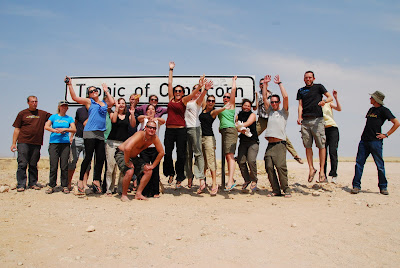We were all feeling a little down at having to leave a friend in hospital in Swakopmund, so the drive to Sesriem was pretty quiet. Scenery wise the sandy desert was replaced by rock and slate mountains.
Suddenly the truck stopped and we realised that it we were about to cross the 'Tropic of Capricorn' (the big sign gave it away). It looks quite different to the scenery around Rockhampton and Gladstone that Claire usually associates this 'line' with. We all took the standard photos and the mood started to lift immediately.
 The whole Kwando crew
The whole Kwando crewThe next stop was for lunch at Solitaire. We were told that it is the smallest town on the Namibian map. There is a petrol station, general store and bakery all run by the same family. It didn't look like the 'town' was any bigger. The apple strudel is mentioned in the guide books as a 'must taste' so that is what we did. It was definitely worth it. A word of warning though, we arrived at nearly 2pm and there were only a couple of pieces left. No worries for us, as the pieces are massive and easily shared between a few. Oh and the guide books are right, it is really good! Our compliments to chef Moose.
Talking of food, possibly our most interesing meal of the trip was served up for lunch. We can't remember the name but the ingredients were condensed milk, peas, mayo and banana. No we aren't making it up and it didn't taste that great. Everyone on the truck gave the 'delicacy' a try and we still don't know if it is a true South African dish as Jacques and JP insisted or a big practical joke!

When we made it to Sesriem we only had a couple of hours before sunset. JP drove us out to the Gorge and took us on a tour of geology of the area. His first instructions were 'walk carefully down the path into the gorge and DO NOT TOUCH ANY OF THE PLANTS'. He brought up the rear and then explained that many of the small bushes were a natural producer of Strychnine.
Sesriem means 'six thongs' which according to the Lonely Planet is how many ox-wagon thongs were needed to reach the bottom and collect water. These days the canyon is 2km long and about 30m high. Inside the canyon you get a real appreciation of how powerful the water must be. The sides are quite crumbly and you can see where pieces have recently broken off. The canyon is still a part of the Namib desert so the dry riverbed of the Tsauchab River that forms the gorge only has running water every 10yrs or so. Surprisingly there was a small pool of water at one end containing a baby python (that we noticed after we'd walked through)! We decided to delay the return to camp in favour of watching sunset on the edge of the canyon.
Steve doing the gentlemanly thing. The snake was in the water behind us.








